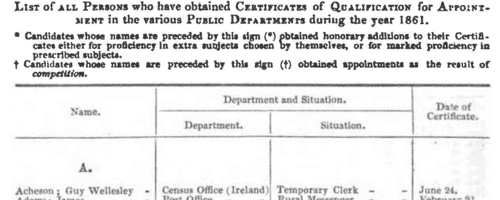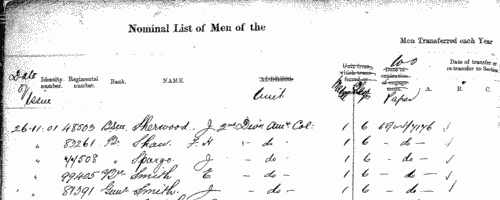Victims of Outrages: Kilmacrenan barony, county Donegal
(1851)
Return of outrages specially reported by the constabulary as committed within the barony of Kilmacrenan, county Donegal: giving date of the offence; parish and townland; name and class of the injured person; nature of the offence; number of persons arrested; and whether conviction was had or not.MCDEVITT. Cost: £6.00.  | Sample scan, click to enlarge

|
Civil Service Appointments
(1861)
The Civil Service Commission published an annual list of all persons who had obtained certificates of qualification for appointment in the various public departments. The list gives full name (surname first); department (such as Post Office, or Inland Revenue); situation (such as Letter-carrier, or Clerk); and date of certificate. Candidates whose names are preceded by a dagger obtained appointments as the result of competition; a double dagger indicates open competition. Those whose names are preceded by an asterisk obtained honorary additions to their certificates either for proficiency in extra subjects chosen by themselves, or for marked proficiency in the prescribed subjects. Then follows a further list of these candidates who had obtained Honorary Additions to their Certificates in this way: giving name (surname and initials); position in the service (department and situation); subjects for which honorary additions were made; and 'extent of knowledge displayed' (such as Creditable, Fair, or Very Creditable). 1 January to 31 December 1861.MCDEVITT. Cost: £4.00.  | Sample scan, click to enlarge

|
Victoria Intestates
(1864)
The probate courts of the Australian colonies furnished returns of estates of deceased intestates, giving full name, colonial residence, amount of the estate and how much had been disbursed and how. The date of death is often stated, and if by accident, suicide or crime. Names were carried forward from return to return until the estate was expended or exhausted. MCDEVITT. Cost: £6.00.  | Sample scan, click to enlarge

|
 Men of the Royal Irish regiment who fought in the New Zealand War
(1863-1870) Men of the Royal Irish regiment who fought in the New Zealand War
(1863-1870)
New Zealand War Medal roll for the 2nd battalion, the 18th (Royal Irish) Regiment of Foot: for service in the New Zealand campaign 1863 to 1867: the rolls were compiled following a general order in 1869 and the medals were distributed in 1870. MCDEVITT. Cost: £8.00.  | Sample scan, click to enlarge

|
Irish Debtors and Bankrupts
(1880)
Bills of sale (binding assets to a creditor/lender), and bankruptcies in Ireland, October to December 1880MCDEVITT. Cost: £6.00.  | Sample scan, click to enlarge

|
 Royal Irish Fusiliers fighting in Egypt
(1882) Royal Irish Fusiliers fighting in Egypt
(1882)
The war medal roll for the Egyptian campaign of 1882 is annotated to show those men actually present at Tel-el-Kebir, and thereby also entitled to the Tel-el-Kebir clasp. In addition, there follows an almost duplicate roll of men entitled to the Bronze Star granted by the Khedive of Egypt in recognition of the campaign. The 1st battalion, Princess Victoria's (Royal Irish Fusiliers) was sent out from home for the Egyptian campaign in early 1882 and returned before the end of the year, having taken part in the battle of Tel-el-Kebir. The medal roll was compiled at Aldershot in December 1882.MCDEVITT. Cost: £8.00.  | Sample scan, click to enlarge

|
 London Policemen
(1878-1891) London Policemen
(1878-1891)
The Metropolitan Police Register of Joiners (MEPO 4/335) lists policemen joining the force 1 July 1878 to 31 December 1891 (warrant numbers 62845 to 77318). The register is alphabetical, in so far as the recruits are listed chronologically grouped under first letter of surname (I and J, and U and V being treated as single initials). It gives Date of Appointment, Name, Number of Warrant, Cause of Removal from Force (resigned, dismissed, promoted or died), and Date of Removal. MCDEVITT. Cost: £8.00.  | Sample scan, click to enlarge

|
 British artillerymen fighting in South Africa
(1899-1902) British artillerymen fighting in South Africa
(1899-1902)
The Queen Victoria's South Africa Medal was awarded (after her death, in the event) to all who had served honourably in the various campaigns in the Boer War. Returns were made from each unit, and consolidated into nominal roll, of which this is the one for the Royal Artillery. Confusingly, the ledgers used had originally been printed for a register of men transferred (or re-transferred after mobilization) to 1st Class Army Reserve. All the original column headings were therefore struck through, and the roll was prepared with this information: Date of Issue; Regimental Number; Rank; Name; Unit; Medal (a 1 indicating that a medal was awarded); [number of] Clasps; the reference to the source in the original returns, usually starting with AG for papers in the hands of the Adjutant-General, and 68/Art/ for the Royal Artillery records. The final column, normally left blank, was occasionally used for explanatory remarks.MCDEVITT. Cost: £8.00.  | Sample scan, click to enlarge

|
Research your ancestry, family history, genealogy and one-name study by direct access to original records and archives indexed by surname.











